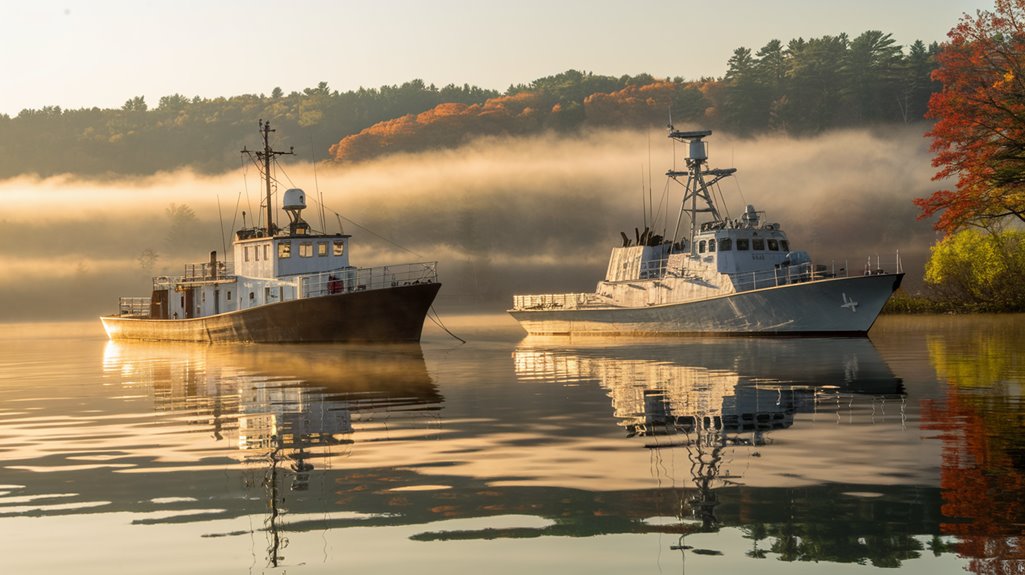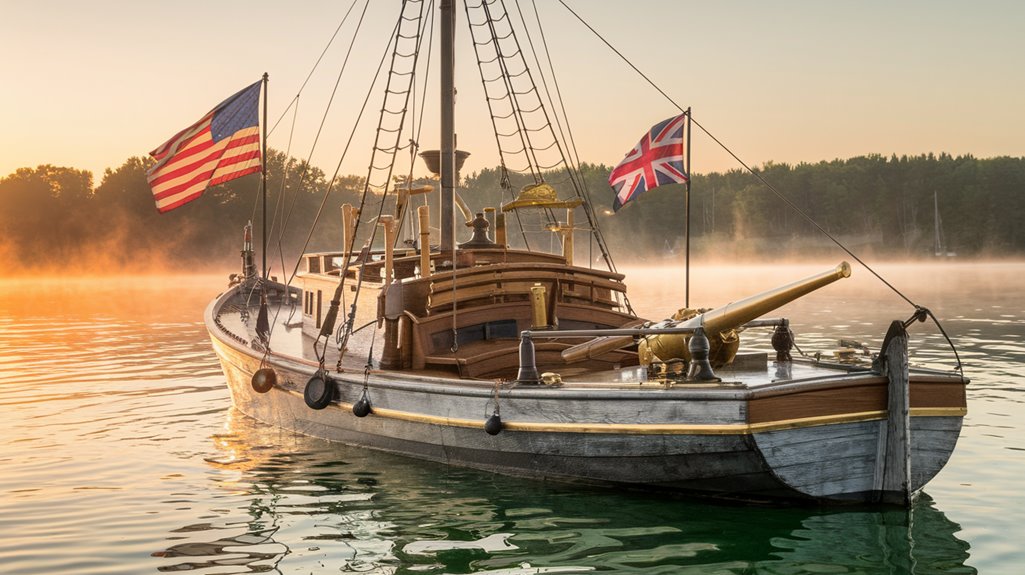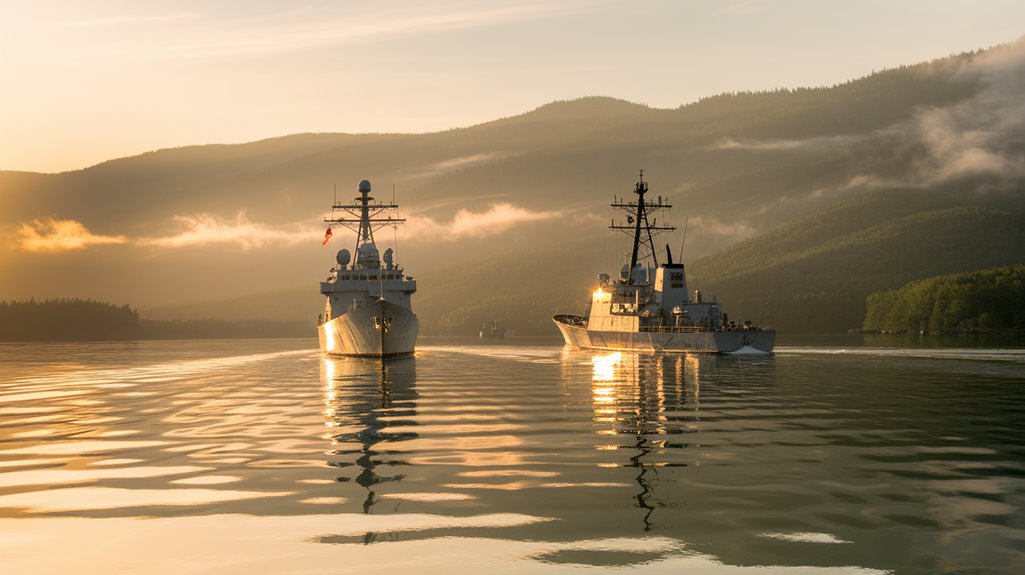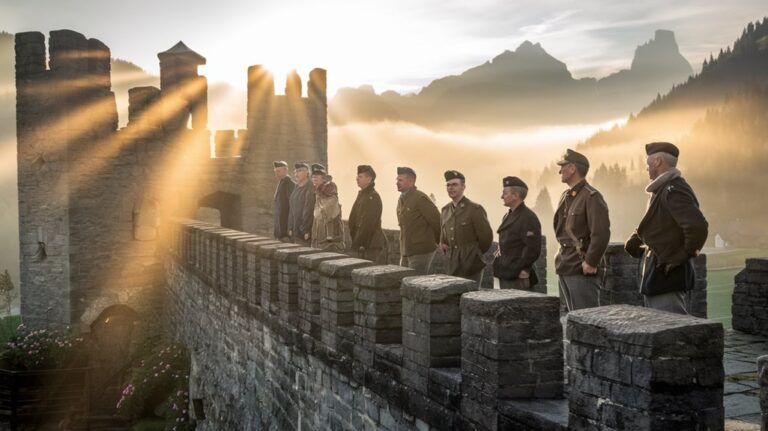The Smallest Naval Battle: One Lake, Two Countries, Big Drama
You've probably heard of epic naval battles spanning vast oceans, but have you considered what happens when two nations clash over a single lake? While history books overflow with grand maritime conflicts, this peculiar story shrinks the scale to its essence: one body of water, two determined countries, and enough drama to fill the depths below. As you explore this lesser-known confrontation, you'll discover how small spaces can create enormous tensions between neighbors.
The Battle That Never Was: Unraveling Historical Records

While many naval battles throughout history have captured the imagination of scholars and history enthusiasts, "The Smallest Naval Battle" remains an enigma with no concrete historical evidence to support its existence.
Naval warfare saw a dramatic shift from individual ship combat to the emergence of line of battle formations, yet no records exist of small-scale lake engagements during this period.
When you explore archival discoveries from the U.S. National Archives and historical narratives surrounding lake-based conflicts, you'll find no mention of this purported battle.
Instead, you'll uncover well-documented boundary disputes resolved through treaties like the Treaty of Ghent and the Webster-Ashburton Treaty.
While colonial powers did create artificial borders along lakes that led to tensions, these disputes were typically resolved through diplomatic channels rather than naval confrontations. The Anglo-Zanzibar War of 1896 stands as a rare exception, being the shortest recorded war in history, lasting only 38-45 minutes.
The records from boundary commissions and arbitrations show that most lake-related conflicts were settled through negotiation, not combat.
Naval Forces and Military Preparations
The lack of historical evidence for the "Smallest Naval Battle" stands in stark contrast to the well-documented military preparations and naval forces that shaped Great Lakes history.
The Rush-Bagot Agreement of 1817 transformed naval strategy in the region, limiting each nation to just four small vessels with single cannons. British and American planners invested heavily in canal systems to maintain secure supply lines and communications. Recent developments reflect the trend, as India has undertaken 73 strategic roads and other infrastructure projects along its borders.
You'll find that this early example of military diplomacy emerged from the intense naval rivalry during the War of 1812, when British and American commanders raced to build larger fleets using local timber.
While major warships were laid up, both sides maintained their dockyards and could reactivate vessels if needed.
This practical arrangement prevented an arms race while preserving each nation's ability to defend their interests, establishing a precedent for peaceful coexistence on the Great Lakes.
Strategic Importance of the Lake
Situated at a significant intersection of disputed territories, Pangong Tso lake commands considerable strategic importance in eastern Ladakh.
Beyond its geopolitical significance as a natural boundary between India and China, the lake serves as an essential vantage point for military operations and resource competition in the region.
You'll find that control over this body of water directly impacts access to vital patrolling points and military mobility. The lake's strategic value was notably demonstrated during the 1962 Sino-Indian War, when major military confrontations occurred in the region. Recent agreements have established that Indian troops will conduct coordinated patrols twice monthly to maintain territorial presence.
- The lake's western portion (45 km) under Indian control provides fundamental military advantages and monitoring capabilities.
- China's infrastructure development, including bridges and bunkers, demonstrates long-term strategic intentions.
- The Depsang Plains near the lake offer potential launch points for military operations.
This unique setting, where the LAC crosses through water, creates complex challenges for both nations in maintaining territorial sovereignty and security interests.
Diplomatic Tensions Leading to Conflict
Strategic interests around Pangong Tso evolved into broader diplomatic challenges between India and China, reflecting a common pattern in territorial disputes worldwide.
You'll find similar tensions in the ongoing dispute between Tanzania and Malawi over Lake Nyasa, where border negotiations have been complicated by competing resource claims.
When you examine these lake disputes closely, you'll notice they often follow a predictable pattern of escalation.
Resource disputes, particularly over oil and gas exploration rights, can transform seemingly manageable border disagreements into potential flashpoints.
In the Tanzania-Malawi case, the arrest of eight Tanzanians near Malawi's uranium mine heightened tensions considerably.
Despite SADC's mediation efforts led by former Mozambican President Joachim Chissano, the situation remains delicate, demonstrating how territorial conflicts can quickly spiral into broader diplomatic crises.
The balance of power between neighboring states often determines the intensity of such territorial disputes.
Recent presidential talks at AU helped ease tensions between the two nations, as leaders showed unity through public displays of solidarity.
The Maritime Showdown

Naval warfare on inland waters presents a fascinating study in contrasts, particularly in two of history's most significant lake battles.
You'll find that both the Battle of Valcour Island and the Battle of Lake Erie showcased remarkable tactical maneuvers in confined spaces, where fleet composition played a vital role in determining victory.
- Ships maneuvered in tight formations, using islands and shorelines as natural shields
- Commanders adapted oceanic battle strategies to work within the lakes' unique constraints
- Smaller vessels proved more effective than their larger ocean-going counterparts
Much like the chaos that ensued during the Naval Battle of Guadalcanal, these lake engagements often resulted in confusion and miscommunication between vessels.
Unlike massive ocean battles, these lake engagements required precise timing and intimate knowledge of local conditions. Quality research methods enabled commanders to develop effective battle strategies based on local intelligence and geographical features.
Whether it was Benedict Arnold's strategic retreat at Valcour Island or Oliver Hazard Perry's bold ship-to-ship combat on Lake Erie, you're witnessing how confined waters demanded innovation and adaptability from naval commanders.
 Greek fire invention in 678 CE revolutionized naval combat, particularly during the Byzantine-Arab Wars. Just as UNT's Digital Library users span more than 200 countries today, these historic naval conflicts reached far beyond their geographic boundaries.
Greek fire invention in 678 CE revolutionized naval combat, particularly during the Byzantine-Arab Wars. Just as UNT's Digital Library users span more than 200 countries today, these historic naval conflicts reached far beyond their geographic boundaries.
Beyond military impact, these battles carry deep cultural significance.
Consider how Aeschylus transformed the Battle of Salamis into "The Persians," creating the oldest surviving Greek play.
You can trace how these encounters sparked dramatic shifts in global power, like when Tsushima's outcome weakened Ottoman naval dominance.
Even today, you'll notice how these historic skirmishes continue to influence modern naval strategy and inspire countless works of literature and art, proving that size doesn't always determine historical importance.










